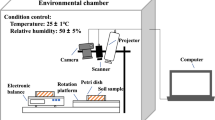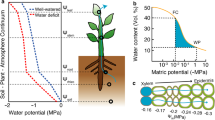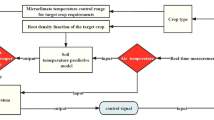Abstract
Modeling the water uptake by plant roots is a key issue in studying soil processes, which are governed by water dynamics: a comprehensive understanding and forecast of such dynamics is a relevant issue in managing water resources. Typically, movement of water in soils and uptake by roots are described by the Richards’ equation with a sink term, and numerical treatment of this problem is still a challenge, together with its practical implementations in user-friendly softwares. In order to tackle this problem, in the present paper we propose a simple and computationally fast algorithm developed as a Python code, implementing a numerical approach based on the shooting method, a classical tool for handling boundary value problems (BVPs) arising here from a discretization recently introduced for Richards’ equation: such a method is applied to the linearized Richards’ equation with Gardner’s hydraulic functions. This method is implemented also in MATLAB, in order to accomplish comparisons with built-in MATLAB solver for parabolic partial differential equations. The Python code is made available to readers, and is intended to be an easy tool for handling this problem in the framework of Gardner’s constitutive relations, filling the gap of other commercial codes, which do not provide choice of Gardner functions. Many numerical simulations are performed: the results are promising, since the proposed method behaves efficiently and in some cases it is able to converge even when the MATLAB solver fails; mass balance properties and order of accuracy issues are also investigated.



Similar content being viewed by others
References
Albrieu JLB, Reginato JC, Tarzia DA (2015) Modeling water uptake by a root system growing in a fixed soil volume. Appl Math Model 39(12):3434–3447
Arbat G, Puig-Bargués J, Duran-Ros M, Barragán J, de Cartagena FR (2013) Drip-irriwater: computer software to simulate soil wetting patterns under surface drip irrigation. Comput Electron Agric 98:183–192
Babazadeh H, Tabrizi M, Homaee M (2017) Assessing and modifying macroscopic root water extraction basil (Ocimum basilicum) models under simultaneous water and salinity stresses. Soil Sci Soc Am J 81:10–19
Banimahd S, Khalili D, Zand-Parsa S (2017) Development of a simulation model for estimation of potential recharge in a semi-arid foothill region. Water Resour Manage 81(31):1535–1556
Berardi M, Difonzo FV (2020) Strong solutions for Richards’ equation with Cauchy conditions and constant pressure gradient. Environ Fluid Mech 20:165–174
Berardi M, Difonzo F, Notarnicola F, Vurro M (2019) A transversal method of lines for the numerical modeling of vertical infiltration into the vadose zone. Appl Numer Math 135:264–275
Berardi M, Difonzo F, Lopez L (2020) A mixed MoL-TMoL for the numerical solution of the 2D Richards’ equation in layered soils. Comput Math Appl 79:1990–2001
Bergamaschi L, Putti M (1999) Mixed finite elements and Newton-type linearizations for the solution of Richards’ equation. Int J Numer Methods Eng 45:1025–1046
Bergamaschi L, Bru R, Martínez A, Mas J, Putti M (2013) Low-rank update of preconditioners for the nonlinear Richards’ equation. Math Comput Model 57(7):1933–1941
Broadbridge P, Daly E, Goard J (2017) Exact solutions of the Richards equation with nonlinear plant-root extraction. Water Resour Res 53(11):9679–9691
Brunetti G, Šimunek J, Bautista E (2018) A hybrid finite volume-finite element model for the numerical analysis of furrow irrigation and fertigation. Comput Electron Agric 150:312–327
Camporese M, Daly E, Paniconi C (2015) Catchment-scale Richards equation-based modeling of evapotranspiration via boundary condition switching and root water uptake schemes. Water Resour Res 51(7):5756–5771
Carminati A (2012) A model of root water uptake coupled with rhizosphere dynamics. Vadose Zone J 11
Casulli V (2017) A coupled surface-subsurface model for hydrostatic flows under saturated and variably saturated conditions. Int J Numer Methods Fluids 85(8):449–464
Coppola A, Chaali N, Dragonetti G, Lamaddalena N, Comegna A (2015) Root uptake under non-uniform root-zone salinity. Ecohydrology 8(7):1363–1379
Elmaloglou S, Soulis K, Dercas N (2013) Simulation of soil water dynamics under surface drip irrigation from equidistant line sources. Water Resour Manage 27:4131–4148
Farthing MW, Ogden FL (2017) Numerical solution of Richards’ equation: A review of advances and challenges. Soil Sci Soc Am J 81(8):04017025
Friedman SP, Communar G, Gamliel A (2016) DIDAS – user-friendly software package for assisting drip irrigation design and scheduling. Comput Electron Agric 120:36–52
Gardner WR (1960) Dynamic aspects of water availability to plants. Soil Sci 89(2):63–73
Green SR, Kirkham M, Clothier BE (2006) Root uptake and transpiration: from measurements and models to sustainable irrigation. Agric Water Manag 86(1):165–176
Holzbecher E (2012) Environmental modeling using MATLAB. Springer, Berlin
Iliano D, Pop I, Radu F (2021) Iterative schemes for surfactant transport in porous media. Comput Geosci 25(1):805–822
Kees C, Farthing M, Dawson C (2008) Locally conservative, stabilized finite element methods for variably saturated flow. Comput Methods Appl Mech Eng 197(51):4610–4625
Lai W, Ogden FL (2015) A mass-conservative finite volume predictor—corrector solution of the 1D Richards’ equation. J Hydrol 523:119–127
Li H, Farthing M, Miller C (2007) Adaptive local discontinuous Galerkin approximation to Richards’ equation. Adv Water Resour 30(9):1883–1901
Li KY, De Jong R, Coe MT, Ramankutty N (2006) Root-water-uptake based upon a new water stress reduction and an asymptotic root distribution function. Earth Interact 10(14):1–22
Li N, Yue X, Ren L (2016) Numerical homogenization of the Richards equation for unsaturated water flow through heterogeneous soils. Water Resour Res 52(11):8500–8525
Liu Y, Yang H, Xie Z, Qin P, Li R (2020) Parallel simulation of variably saturated soil water flows by fully implicit domain decomposition methods. J Hydrol 582:124481
Manoli G, Huang CW, Bonetti S, Domec JC, Marani M, Katul G (2017) Competition for light and water in a coupled soil-plant system. Adv Water Resour 108:216–230
Manzini G, Ferraris S (2004) Mass-conservative finite volume methods on 2-D unstructured grids for the Richards’ equation. Adv Water Resour 27 (12):1199–1215
Mathews JH, Fink KK (2004) Numerical methods using Matlab, 4th edn. Pearson, London
Mathur S, Rao S (1999) Modeling water uptake by plant roots. J Irrig Drain Eng 125(3):159–165
Mohanadhas B, Kumar G (2019) Numerical experiments on fate and transport of benzene with biological clogging in vadoze zone. Environ Process 6:841–858
Raats PAC (2007) Uptake of water from soils by plant roots. Transp Porous Media 68(1):5–28
Roose T, Fowler A (2004) A model for water uptake by plant roots. J Theor Biol 228(2):155–171
Rucker DF, Warrick AW, Ferré TP (2005) Parameter equivalence for the Gardner and van Genuchten soil hydraulic conductivity functions for steady vertical flow with inclusions. Adv Water Resour 28(7):689–699
Shampine LF, Kierzenka J (2019) MATLAB Version 9.7 (R2019a). The Mathworks Inc. Natick, Massachusetts
Simunek J, Hopmans JW (2009) Modeling compensated root water and nutrient uptake. Ecol Model 220(4):505–521
Suk H, Park E (2019) Numerical solution of the Kirchhoff-transformed Richards equation for simulating variably saturated flow in heterogeneous layered porous media. J Hydrol 579:124213
Tseng PH, Sciortino A, van Genuchten M (1995) A partitioned solution procedure for simulating water flow in a variably saturated dual-porosity medium. Adv Water Resour 18(6):335–343
Utset A, Ruiz M, Garcia J, Feddes R (2000) A SWACROP-based potato root water-uptake function as determined under tropical conditions. Potato Res 43:19–29
Viola F, Noto LV, Cannarozzo M, La Loggia G, Porporato A (2012) Olive yield as a function of soil moisture dynamics. Ecohydrology 5(1):99–107
Wu X, Zuo Q, Shi J, Wang L, Xue X, Ben-Gal A (2020) Introducing water stress hysteresis to the Feddes empirical macroscopic root water uptake model. Agric Water Manag 240:106293
Xu C, Tian J, Wang G, Nie J, Zhang H (2019) Dynamic simulation of soil salt transport in arid irrigation areas under the Hydrus-2D-based rotation irrigation mode. Water Resour Manage 33:3499–3512
Zha Y, Yang J, Yin L, Zhang Y, Zeng W, Shi L (2017) A modified Picard iteration scheme for overcoming numerical difficulties of simulating infiltration into dry soil. J Hydrol 551:56–69
Acknowledgements
The authors wish to thank Mr. Andrea Gargaro from Code Architects for precious suggestions in organizing the code.
Funding
This work is part of the project Smart Water (grant number 5ABY6P0), funded by Regione Puglia through the Innonetwork call: all CNR-IRSA authors have been partially funded by this project.
The first author acknowledges the support of the OP RDE (OP VVV) funded project reg. No: CZ.02.1.01/0.0/0.0/16_019/0000765 - “The Research Center for Informatics”.
Author information
Authors and Affiliations
Contributions
– Fabio V. Difonzo: conceptualization, methodology, software, formal analysis, writing-original draft preparation.
– Costantino Masciopinto: methodology, supervision, validation.
– Michele Vurro: funding acquisition, critical revise of the draft, visualization.
– Marco Berardi: conceptualization, methodology, writing-original draft preparation, data treatment; writing-reviewing and editing, project administration.
Corresponding author
Ethics declarations
Competing interests
The authors have no relevant financial or non-financial interests to disclose.
Additional information
Availability of Data and Materials
The Python code is publicly available at https://github.com/fdifonzo/shooting-roots-python-code
Publisher’s Note
Springer Nature remains neutral with regard to jurisdictional claims in published maps and institutional affiliations.
Rights and permissions
About this article
Cite this article
Difonzo, F.V., Masciopinto, C., Vurro, M. et al. Shooting the Numerical Solution of Moisture Flow Equation with Root Water Uptake Models: A Python Tool. Water Resour Manage 35, 2553–2567 (2021). https://doi.org/10.1007/s11269-021-02850-2
Received:
Accepted:
Published:
Issue Date:
DOI: https://doi.org/10.1007/s11269-021-02850-2




